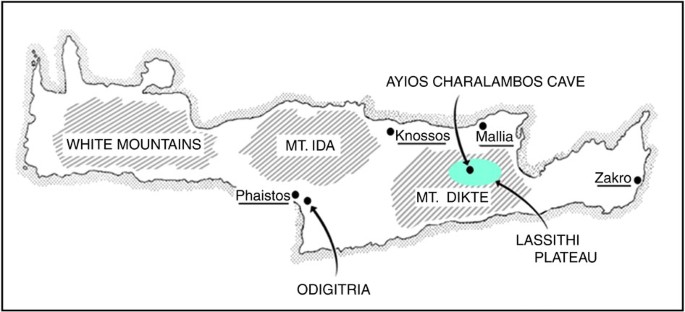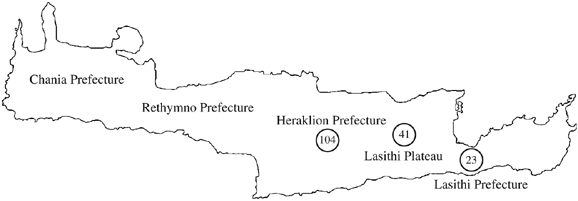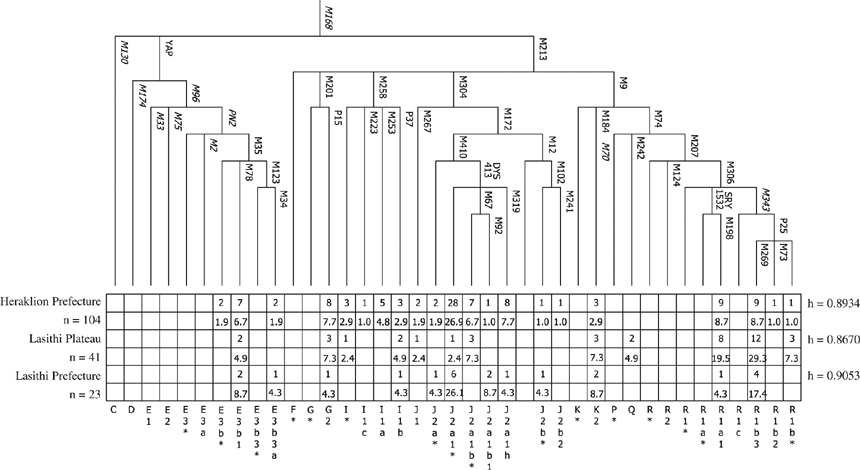| Sample n (Y-DNA) | Site | Date | Y-DNA |
J1a-P58
Sample (n=5) |
|
|
|
| ID HGC001 | Hagios Charalambos cave, Crete | 2300-1900 BC | J1a-P58 (xZ643,Y4067,ZS12454,Y205364) |
| ID HGC002 | Hagios Charalambos cave, Crete |
| J1a-P58 |
| ID HGC005 | Hagios Charalambos cave, Crete |
| J1a-P58 |
| ID HGC013 | Hagios Charalambos cave, Crete |
| J1a-P58 |
| ID HGC063 | Hagios Charalambos cave, Crete |
| J1a-P58 |
J1b-ZS50
Sample (n=2) |
|
|
|
| ID LAZ017 | Lazarides, Aegina |
| J1b-ZS50 |
| ID NST012 | Nea Styra, Euboea |
| J1b-ZS50>ZS5071 |
J2a1-M319
Sample (n=4) |
|
|
|
| ID HGC037 | Hagios Charalambos cave, Crete | 2400-1800 BC | J2a1-M319 |
| ID HGC015 | Hagios Charalambos cave, Crete | 2400-1800 BC | J2a1-M319>Y151557 |
| ID HGC018 | Hagios Charalambos cave, Crete | 2400-1800 BC | J2a1-M319>Y151557 |
| ID HGC031 | Hagios Charalambos cave, Crete | 2400-1800 BC | J2a1-M319>Y151557 |
J2a1a1-Y6240
Sample (n=3) |
|
|
|
| ID HGC006 | Hagios Charalambos cave, Crete |
| J2a1a1-Y6240>BY82631 |
| ID HGC009 | Hagios Charalambos cave, Crete |
| J2a1a1-Y6240>BY82631 |
| ID HGC017 | Hagios Charalambos cave, Crete |
| J2a1a1-Y6240>BY82631 |
J2a-Z7671
Sample (n=3) |
|
|
|
| ID APO025 | Aposelemis, Crete |
| J2a-Z7671 |
| ID XAN041 | Chania, Crete |
| J2a-Z7671 |
| ID TIR010 | Tiryns, Argolis |
| J2a-Z7671 |
J2a-Y17002
Sample (n=1) |
|
|
|
| ID XAN031 | Chania, Crete |
| J2a-Y17002 |
J2a1a2-Y13128
Sample (n=1) |
|
|
|
| ID XAN029 | Chania, Crete |
| J2a1a2-Y13128>Z36829 |
J2a-PF5252
Sample (n=1) |
|
|
|
| ID GLI003 | Glika Nera, Attica |
| J2a-PF5252* |
J2a2-PF5008
Sample (n=3) |
|
|
|
| ID AID007 | Aidonia, Corinthia |
| J2a2-PF5008>Y24510 |
| ID AID008 | Aidonia, Corinthia |
| J2a2-PF5008>Y24510 |
| ID XAN024 | Chania, Crete |
| J2a2-PF5008>MF10501* |
G2a2a-PF3147
Sample (n=3) |
|
|
|
| ID LAZ018 | Lazarides, Aegina |
| G2a2a-PF3147>FGC55322 |
| ID XAN051 | Chania, Crete |
| G2a2a-PF3147>L91>Y130324 |
| ID MYG004 | MBA/LBA Mygdalia, Achaia, Greece | 1600-1450 BCE (~1525 BCE) | G2a2a-PF3147>L91>Y130324 |
G2a2b2-F872
Sample (n=1) |
|
|
|
| ID NST005 | Nea Styra, Euboea |
| G2a2b2-F872>PF3378 |
C1a2-V20
Sample (n=2) |
|
|
|
| ID XAN035 | Chania, Crete |
| C1a2-V20>V3918 |
| ID AID002 | Aidonia, Corinthia |
| C1a2-V20>F16270 |
E1b-CTS10912
Sample (n=1) |
|
|
|
| ID XAN016 | Chania, Crete |
| E1b-CTS10912>BY6578 |
R1b-PF7562
Sample (n=1) |
|
|
|
| ID XAN030 | Chania, Crete |
| R1b-PF7562 |
T1a3b2-Y11151
Sample (n=2) |
|
|
|
| ID HGC010 | Hagios Charalambos cave, Crete |
| T1a3b2-Y11151>BY59831 |
| ID HGC055 | Hagios Charalambos cave, Crete |
| T1a3b2-Y11151>BY59831 |
J2b-L283
Sample (n=4) |
|
|
|
| ID MYG001 | MBA/LBA Mygdalia, Achaia, Greece | 1600-1450 BCE (~1525 BCE) | J2b-L283>Z615* |
| ID MYG008 | MBA/LBA Mygdalia, Achaia, Greece | 1600-1450 BCE (~1525 BCE) | J2b-L283>Z615* |
| ID MYG006 | MBA/LBA Mygdalia, Achaia, Greece | 1600-1450 BCE (~1525 BCE) | J2b-L283>Z615* |
| ID MYG005 | MBA/LBA Mygdalia, Achaia, Greece | 1600-1450 BCE (~1525 BCE) | J2b-L283>Z615* |




